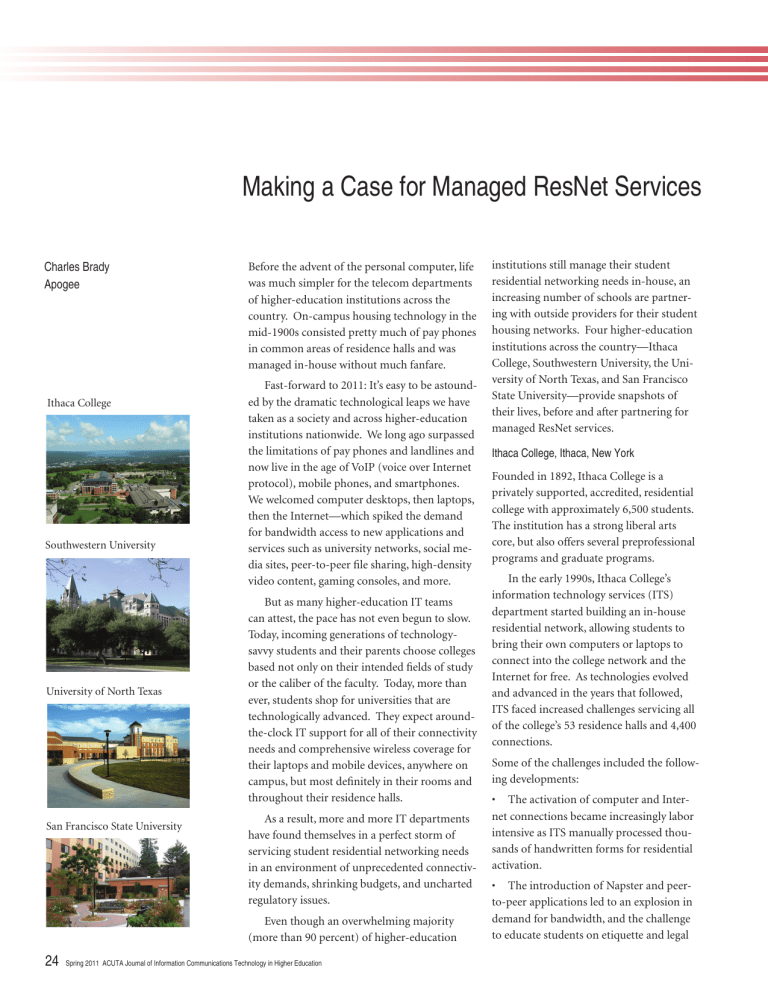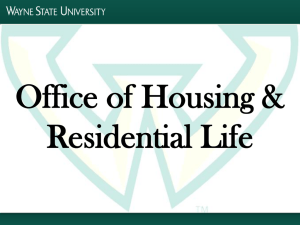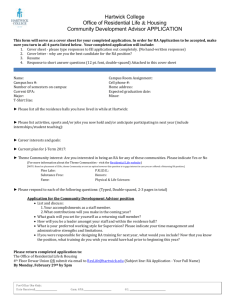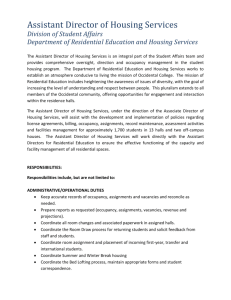Making a Case for Managed ResNet Services

Making a Case for Managed ResNet Services
Charles Brady
Apogee
Ithaca College
Southwestern University
University of North Texas
Before the advent of the personal computer, life was much simpler for the telecom departments of higher-education institutions across the country. On-campus housing technology in the mid-1900s consisted pretty much of pay phones in common areas of residence halls and was managed in-house without much fanfare.
Fast-forward to 2011: It’s easy to be astounded by the dramatic technological leaps we have taken as a society and across higher-education institutions nationwide. We long ago surpassed the limitations of pay phones and landlines and now live in the age of VoIP (voice over Internet protocol), mobile phones, and smartphones.
We welcomed computer desktops, then laptops, then the Internet—which spiked the demand for bandwidth access to new applications and services such as university networks, social media sites, peer-to-peer file sharing, high-density video content, gaming consoles, and more.
But as many higher-education IT teams can attest, the pace has not even begun to slow.
Today, incoming generations of technologysavvy students and their parents choose colleges based not only on their intended fields of study or the caliber of the faculty. Today, more than ever, students shop for universities that are technologically advanced. They expect aroundthe-clock IT support for all of their connectivity needs and comprehensive wireless coverage for their laptops and mobile devices, anywhere on campus, but most definitely in their rooms and throughout their residence halls.
San Francisco State University
As a result, more and more IT departments have found themselves in a perfect storm of servicing student residential networking needs in an environment of unprecedented connectivity demands, shrinking budgets, and uncharted regulatory issues.
Even though an overwhelming majority
(more than 90 percent) of higher-education
24
Spring 2011 ACUTA Journal of Information Communications Technology in Higher Education institutions still manage their student residential networking needs in-house, an increasing number of schools are partnering with outside providers for their student housing networks. Four higher-education institutions across the country—Ithaca
College, Southwestern University, the University of North Texas, and San Francisco
State University—provide snapshots of their lives, before and after partnering for managed ResNet services.
Ithaca College, Ithaca, New York
Founded in 1892, Ithaca College is a privately supported, accredited, residential college with approximately 6,500 students.
The institution has a strong liberal arts core, but also offers several preprofessional programs and graduate programs.
In the early 1990s, Ithaca College’s information technology services (ITS) department started building an in-house residential network, allowing students to bring their own computers or laptops to connect into the college network and the
Internet for free. As technologies evolved and advanced in the years that followed,
ITS faced increased challenges servicing all of the college’s 53 residence halls and 4,400 connections.
Some of the challenges included the following developments:
• The activation of computer and Internet connections became increasingly labor intensive as ITS manually processed thousands of handwritten forms for residential activation.
• The introduction of Napster and peerto-peer applications led to an explosion in demand for bandwidth, and the challenge to educate students on etiquette and legal
ramifications around the proper use of a shared network, as well as that of dealing directly with copyright holder complaints and student infractions.
• Beyond computers, expectations rose for speedy and seamless connectivity as students also began bringing additional devices to their residence halls: DVD players, gaming consoles, smartphones, and more.
• A virus plagued campus computers. In
August 2003, Ithaca College was plagued by a worldwide virus epidemic that coincided with move-in season. It soon became apparent that all a student had to do was plug into Ithaca’s ResNet to infect their computer. The college created an emergency response team and activated resident assistants to help individual students clean and patch computers. ITS monitored infection levels at each building and shut down Internet access when infection levels were deemed too high while continuing to work with individual students and turning connection ports on or off. Although the virus problem was resolved by Labor Day weekend, it angered many students, along with their parents, with a few even asking for tuition refunds.
The multitude of issues prompted
Ithaca College to question the feasibility of having ITS continue to provide support through its in-house resources, or whether partnering with a third party would be more resource-effective and improve service. Ithaca College decided to implement managed residential services in 2004, and in just four months, they had achieved the goals they set out to accomplish:
• Creation of a tiered Internet service plan, including a no-cost option for students
• On-site technical support and aroundthe-clock phone support for all students living in the 53 residence halls
• Increased bandwidth that scales as technologies advance and the college continues to grow and expand
• The creation of a network architecture that would not be affected by viruses, worms, and Trojans we focusing on our core strategic mission for the university—to support academics and research—or were we simply an Internet service provider for students?”
• The establishment of a collaborative relationship and partnership with an experienced vendor who understood the academic market and the law
Once the pivotal decision was made,
Southwestern changed its residential networking model from in-house to managed services in a two-stage process:
Ed Fuller, director of information technology, summed up their experience this way: “We simply weren’t equipped or chartered to be an ISP. Turning that business over was a good business decision for
Ithaca College.”
Southwestern University, Georgetown, Texas
1. Hardware upgrade. To facilitate bandwidth expansion, Southwestern was able to leverage a no-cost upgrade of its existing network infrastructure, which included a full-scale deployment of core routing and switching equipment. Hubs in the residence halls were replaced with new 10/100 switches, and building links were upgraded from 10 Mbps to 1,000 Mbps.
Founded in 1840, Southwestern University is the oldest university in Texas. It is a selective, four-year, independent, undergraduate national liberal arts college that has been consistently ranked among the nation’s leading private colleges academically.
When the school’s information technology services (ITS) department introduced residential networking for the approximately 1,100 students who lived in the residence halls in the mid-1990s, it had a simple goal: to provide students with e-mail access and a way to surf the limited information-based Internet available at that time.
2. Move-in and connectivity support. In previous years, campus housing and ITS offices were overloaded with support needs during the busy move-in seasons. The decision to shift campus housing connectivity and networking issues to the managed
ResNet provider’s on-site technician and
24/7 support hotline led to a dramatic reduction of calls to the campus help desk, freeing up time for administrators to focus on other issues.
But in a span of only a few years, students found many new uses for the network, as they began to download rich media (audio and video) en masse and exchange large files through peer-to-peer file-sharing networks. Southwestern’s ITS department found itself under constant pressure to provide more and more bandwidth and to take more staff time and resources away from the core IT activities of the university. Mounting challenges prompted Southwestern’s leadership to consider in-house residential networking.
Both Southwestern’s ITS department and students were pleased with their new residential networking setup. Reporting on his work life after turning over ResNet,
Todd Watson, senior network administrator, said, “I haven’t had to look at the bandwidth and data traffic flow since the project came online. I’ve already had enough time to implement a long-awaited systems project that normally would have been delayed with the start of the semester.”
University of North Texas
With an enrollment of more than 34,000 students, the University of North Texas
(UNT) is the flagship campus of the UNT
CIO Bob Paver summed up their dilemma: “The natural question was, were
System and the fourth largest university in
4
ACUTA Journal of Information Communications Technology in Higher Education Spring 2011
25
Texas. More than 6,000 students live on campus in its 14 residence halls, making
UNT the largest residential campus in the
Dallas–Fort Worth area.
By the spring of 2007, UNT residence halls were feeling increased pressure to stay competitive with the Internet connection speeds to which students were accustomed.
Students complained of delays in network connections and increasingly demanded wireless Internet access. At that time, UNT maintained a full-time employee dedicated exclusively to managing ResNet activity, but
75 percent of his time was spent tracking issues, turning ports on and off, and dealing with PCs that were hogging bandwidth.
However, he was unable to address the underlying infrastructure upgrades needed to meet the heightened expectations in the residence halls.
The decision to implement managed residential network services at UNT solved the problem on multiple levels.
1. Infrastructure boost. By leveraging managed ResNet services, UNT traded in the costs of maintaining its aging infrastructure for a stable, predictable cost system with built-in technology refreshes.
UNT also implemented more infrastructure upgrades, bringing in additional routers, putting up firewalls, and adding software revisions.
2. Enhanced student support. UNT introduced on-site and around-the-clock technical support for its 6,000 resident students, vastly speeding up the response time in troubleshooting any connectivity and bandwidth issues.
3. Savings in labor costs. With technical support now off its plate, UNT was able to save significant staff hours and costs on the residential networking front. Staff and resources could be redeployed to other campus applications to support the school’s larger academic goals. “It’s like adding staff without adding staff,” said Joe Adamo, director of communication services.
Reflecting on life before and after managed ResNet services, Adamo added, “With the number of connections, we could not keep up in the past. We now have upgraded service packages and a 24-hour help desk.”
San Francisco State University
San Francisco State (SFSU) is a leading urban public university and part of
California State University, the largest system of higher education in the country. Enrollment at SFSU had climbed past
29,000 students on its 134-acre campus in southwest San Francisco. With enrollment increasing significantly, SFSU undertook an ambitious project to acquire several largescale residential communities adjacent to the campus, and along with this, expand its existing housing network to 12,000-plus connections.
During that period, the university came face to face with multiple challenges: It needed not only to integrate smoothly the new properties with the rest of SFSU, but also to upgrade its existing network and establish new residential networks that would meet rising student expectations for higher bandwidth and wireless connectivity as video streaming and “Internet access everywhere” became the prevalent expectation among students.
In addition, SFSU faced budget and time constraints and had limitations on what it could spend on new staff or equipment. SFSU determined that its best strategy was to partner with a specialized and experienced network provider and selected a partner with the ultimate goal of achieving a residential network infrastructure so flexible and dependable that it is expected to meet campus technology demands for the next 15 years.
With its new partner, SFSU quickly rolled out the following improvements:
• Full build-out of a new residential network at newly acquired student housing properties, including laying of underground fiber, establishment of server rooms, and wiring for high-speed Internet connections.
• Full infrastructure upgrade and integration of existing and new residence halls, allowing for a scalable, fully integrated voice/video/data network that provided students with high-speed Internet and comprehensive wireless coverage.
• Full-service plans and packages, which were embraced by the student population. They can now count on complete on-site support and maintenance as well as around-the-clock technical support. Technologically advanced students who want higher bandwidth and ultra-high-speed connectivity also have the option to buy into service packages that deliver beyondbasic access.
Best of all, the university was able to keep the administrative control it wanted.
The IT team was able to maintain focus on supporting the university’s expansion and academic goals while handing off the timeconsuming, detail-driven job of running and maintaining 12,000-plus connections in the student residential network.
Along with the rest of the country, higher-education institutions are challenged to deliver more with fewer resources during these difficult times. Managed residential networking, while a relatively new trend, is capturing the attention and fascination of an increasing number of administrators as they consider ways to run student housing networks that have the potential to work better and save money.
Charles Brady is founder and CEO of Apogee. Reach him at cbrady@apogeenet.net.
u
26
Spring 2011 ACUTA Journal of Information Communications Technology in Higher Education





